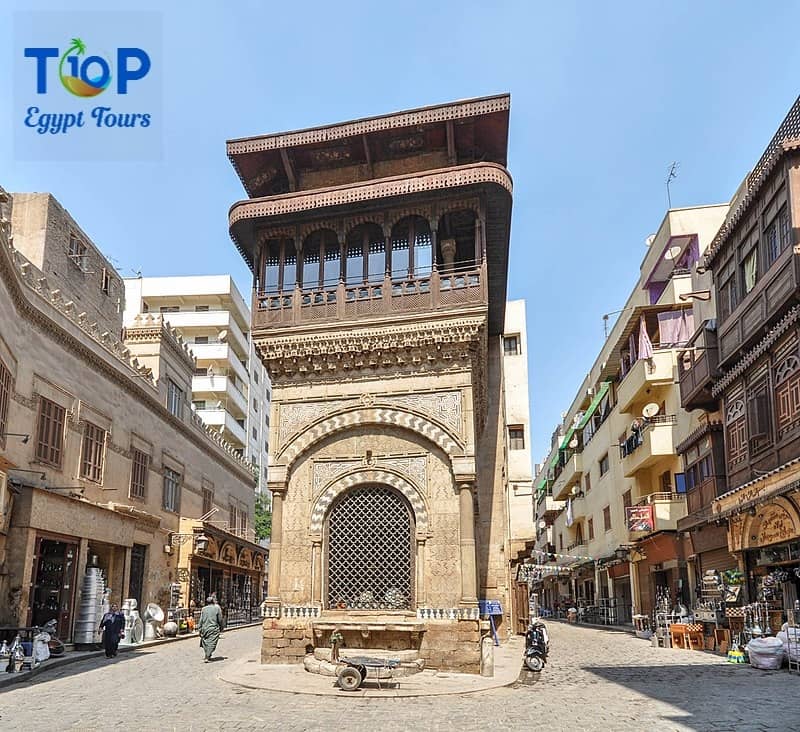The Sabil of Abdelrahman Katkhuda is a notable historical structure located in Cairo, Egypt. It follows a similar layout to other sabils (public water dispensing stations) found throughout Cairo, but it possesses its own unique architectural features and historical significance. This article with Top Ten Egypt explores the layout and key facts about the Sabil of Abdelrahman Katkhuda, shedding light on its historical context and architectural elements.
Sabil of Abdelrahman Katkhuda:
The Sabil of Abdelrahman Katkhuda was built in the late 18th century during the rule of Ottoman Egypt. It was commissioned by Abdelrahman Katkhuda, a prominent Mamluk-era official who served as the overseer of Egypt’s water resources. The sabil was constructed as a charitable initiative, providing clean drinking water to the public, particularly during the scorching summer months.
Traditional Sabil Layout:
The Sabil of Abdelrahman Katkhuda follows the traditional layout of sabils found in Cairo. It typically consists of a rectangular structure with a central facade facing the street. The facade features intricate decorations, including geometric patterns, floral motifs, and Quranic inscriptions, showcasing the skilled craftsmanship of the time. The structure is usually built with limestone or other locally available materials.
Water Distribution:
At the heart of the Sabil of Abdelrahman Katkhuda is a central chamber that houses a fountain or a basin for water distribution. The water source was often an underground well or a nearby water canal. The chamber would have openings or windows, allowing people to access the water without entering the structure. The sabils played a vital role in providing free, clean water to the local community, serving both practical and charitable purposes.
Architectural Features:
The Sabil of Abdelrahman Katkhuda stands out with its architectural features. The facade is adorned with intricate carvings and decorative elements, showcasing a blend of Ottoman and Mamluk architectural styles. The use of geometric patterns, calligraphy, and arabesque designs is prevalent, creating an aesthetically pleasing and visually striking appearance.
Historical Significance:
The Sabil of Abdelrahman Katkhuda is a notable historical structure located in Cairo, Egypt. It follows a similar layout to other sabils (public water dispensing stations) found throughout Cairo, but it possesses its own unique architectural features and historical significance. This article explores the layout and key facts about the Sabil of Abdelrahman Katkhuda, shedding light on its historical context and architectural elements.
Sabil of Abdelrahman Katkhuda:
It was built in the late 18th century during the rule of Ottoman Egypt. It was commissioned by Abdelrahman Katkhuda, a prominent Mamluk-era official who served as the overseer of Egypt’s water resources. The sabil was constructed as a charitable initiative, providing clean drinking water to the public, particularly during the scorching summer months.
Traditional Sabil Layout:
It follows the traditional layout of sabils found in Cairo. It typically consists of a rectangular structure with a central facade facing the street. The facade features intricate decorations, including geometric patterns, floral motifs, and Quranic inscriptions, showcasing the skilled craftsmanship of the time. The structure is usually built with limestone or other locally available materials.
Water Distribution:
At the heart of the Sabil of Abdelrahman Katkhuda is a central chamber that houses a fountain or a basin for water distribution. The water source was often an underground well or a nearby water canal. The chamber would have openings or windows, allowing people to access the water without entering the structure. The sabils played a vital role in providing free, clean water to the local community, serving both practical and charitable purposes.
Architectural Features:
It stands out with its architectural features. The facade is adorned with intricate carvings and decorative elements, showcasing a blend of Ottoman and Mamluk architectural styles. The use of geometric patterns, calligraphy, and arabesque designs is prevalent, creating an aesthetically pleasing and visually striking appearance.
Preservation and Restoration:
Like many historical structures, the Sabil of Abdelrahman Katkhuda has undergone periods of deterioration and restoration. The Egyptian government and various organizations have made efforts to preserve and restore the sabil, ensuring its architectural integrity and historical value are maintained. Restoration projects aim to repair damages, protect the decorative elements, and ensure the sustainability of the structure for future generations.
In conclusion, the Sabil of Abdelrahman Katkhuda follows the traditional layout of sabils in Cairo, serving as a historic water dispensing station. Its architectural features, intricate decoration and historical significance make it a remarkable example of Ottoman-era architecture and philanthropy. The sabil stands as a testament to the importance of public welfare and community service, providing a glimpse into the cultural and historical fabric of Cairo.
Browse our complete list of Egypt tours Click Here



Comment (0)